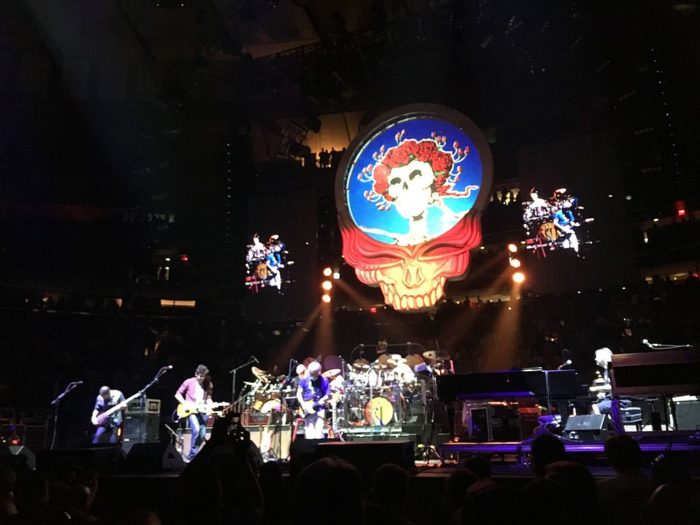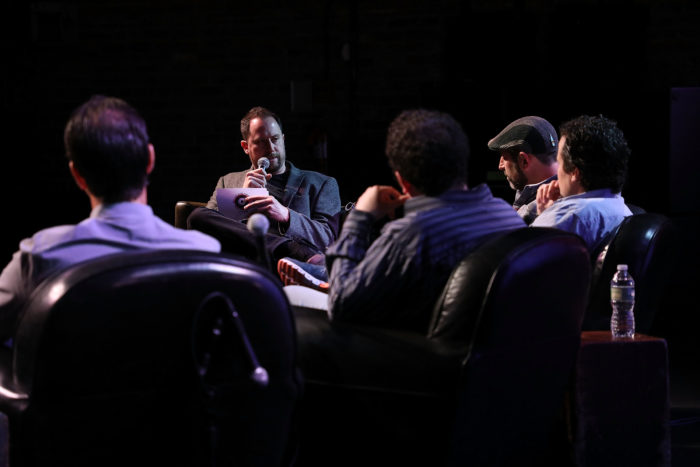What the Music Biz Loves About Live Streaming
At a Brooklyn conference, industry experts sing the praises of a technology that could help save the business
When the Dead & Company live-streamed parts of their concerts, demand for tickets only grew (Photo courtesy of Wikipedia Commons)
Streaming video, from providers including Netflix and Hulu, appears to be decimating the movie-theater industry. Box office sales across the U.S. hit a 22-year low in 2017, a 6% decline from 2016. New Yorkers have watched several beloved movie theaters shutter their doors in recent years, including Brooklyn’s Park Slope Pavilion Theater and the Kings Plaza Theater. Theater owners are attempting to reimagine the moviegoing experience, adding waiter service for food and beverage, but it’s not clear whether the makeover will bring a happy ending.
Yet streaming may play out differently when it comes to live music. Many people in the industry say the streaming of concerts, especially live video beamed into homes via Facebook, YouTube and other platforms, has had a reinvigorating effect on their business. They believe the technology could be a win for everyone involved: music lovers, performers, venue owners, and the industry as a whole.
That was the encouraging view at this year’s Relix Live Music Conference, taking place this week at Williamsburg’s Brooklyn Bowl. Organized by the Relix Media Group, known for its publication devoted to live music and industry news, the conference covers topics ranging from the growth of festivals to relationship-building between talent and management.

Panel moderator Jonathan Healey and music-industry experts talked about the benefits of live streaming (Photo by Taylor Hill, courtesy of Relix Live Music Conference)
Since live music and its sponsorships represent the majority of all revenue in the music industry, the arrival of technology that makes live streaming of concerts easier to execute and more accessible to music fans is a game-changing development. To assess its impact, Relix assembled a panel of experts on the subject to kick off the conference: moderator Jonathan Healey of Dayglo Ventures; Ted Kartzman, head of independent label partnerships for YouTube and Google Play Music; Jake Saxbe, CEO of TourGigs concert films; David Onigman, CEO of JamBase; and Brad Serling, founder and CEO of nugs.net. Their observations on live streaming:
It’s cheaper and more efficient than before
Serling recalled a 1996 Moe concert that featured an audio-only “live cast” on the internet, which he created by running a phone line down an aisle from his laptop to a jack underneath the stage. Some of the early live-streamed concerts in the early ’00s required the presence of oversized production trucks parked outside the concert venue.
Such accommodations are no longer necessary. Remote cameras zoom across the rafters, camera operators capture quality images with lightweight digital equipment, and there’s Wi-Fi connecting everything. It was said during the panel, too, that a venue–depending on its size–could be hard-wired for live streaming for less than $15,000. After that, the only costs incurred would be for a small team including a couple of camera operators and an on-site producer, all of whom could simply plug into the venue’s system.
It helps generate extra content for fans to enjoy
Live streaming and the high-quality digital video of today “feeds the beast. It gives us something to write about the show the next day,” said Onigman, whose website publishes articles alongside ticket listings. Onigman observed that live streaming brings accountability to the coverage of bands’ concerts; in the past, show reviews were consumed with the presumption they were accurate. “We love that stuff,” Onigman continued, referring to streaming video and its capabilities. “More of this stuff coming up makes it easier to cover these bands and to create interest in the next night’s show or the next time the band comes around.” Which is to say…
Live streaming has increased ticket sales
An agreeably counterintuitive fact, but with statistics supporting it nonetheless, panel members–and at least one audience member during the Q. and A. portion–insisted live streaming does not compel people to skip out on shows and situate themselves on their sofas to watch musical performances. If anything, it gets people excited to get out of the house.
Serling recounted Dead & Company’s tour last summer, in which the combo of former Grateful Dead members initially offered a mix of pay-per-view live-streamed shows and freebie teasers of a few songs at a time on Facebook Live and the band’s YouTube channel. “Incrementally, throughout the tour, we saw the buildup at the walk-up box-office sales,” he said.
By the time the band got to Wrigley Field in Chicago, to close out the tour, they enjoyed the highest walk-up sales of all. “They saw a direct correlation between the live streams we were doing every night, the huge audiences we were amassing on Facebook and YouTube, and then the eventual walk-up at the end of the tour.”

The industry conference is in its second year (Photo by Michael Stahl)
It’s an added revenue source for the performers
If live streaming doesn’t have an adverse effect on concert ticket sales, then bands can also sell video access to their full-length performances at a premium. This can at least partially make up for the loss of money that used to be pulled in through album sales, which between 2015 and 2016 “tanked” in every format except on-demand streaming, according to Forbes. (While streaming music has revived revenues, they still lag behind the fortunes that the old formats brought in.)
Another benefit of live streaming is that brand integration–like commercials on TV or pop-up ads on websites–can be incorporated with ease as well, which means more money for the performer. To help the industry sell ads, live streaming offers plenty of metrics: overall views, lengths of watch times, and “reach” on Facebook. Then there are those ubiquitous email newsletters, which musicians, venues and streaming services may have an easy time getting diehard fans to sign up for as they pay for the video.
It makes live performances better
With fans fixing their eyes on tour performances ahead of local dates they may attend, the panel pointed out that artists need to stay on their toes a bit more, mixing up their set lists so they don’t repeat themselves too much. Better performances mean fans will get out to see the acts more often.
I asked the panel if, even with all their optimistic observations and data to support them, they’re concerned about people not going out to shows. “I think my kids keep me from going to shows, that’s what’s great about live streaming,” said Kartzman. For devotees like him, however, it’s a reasonable facsimile that doesn’t dampen the love of being there. “There is nothing like a live concert; that is church for people like us. We go to shows to be with like-minded people … that’s what it’s all about. But when I can’t go because I’m changing diapers all night, then I would love to do that over a live stream of a Portugal. The Man show.”













